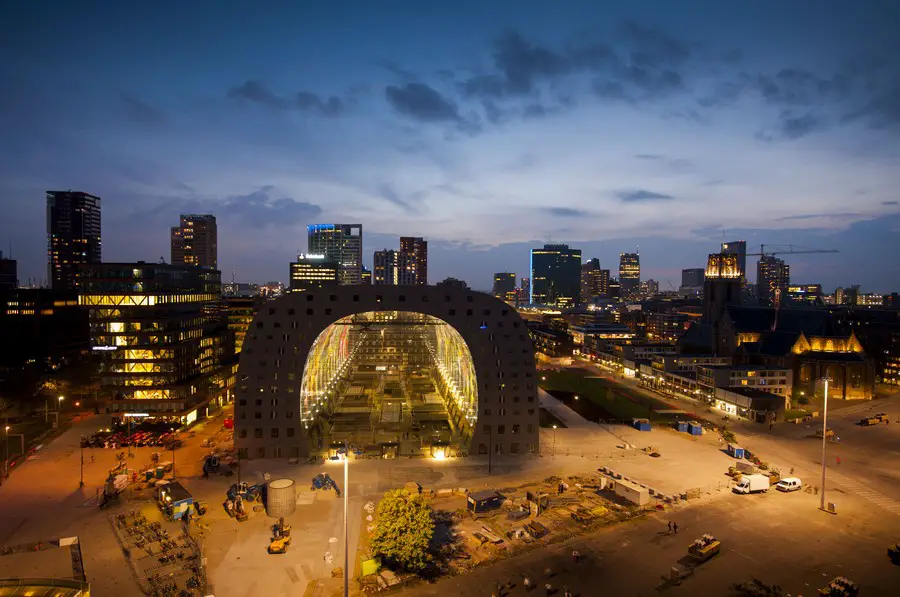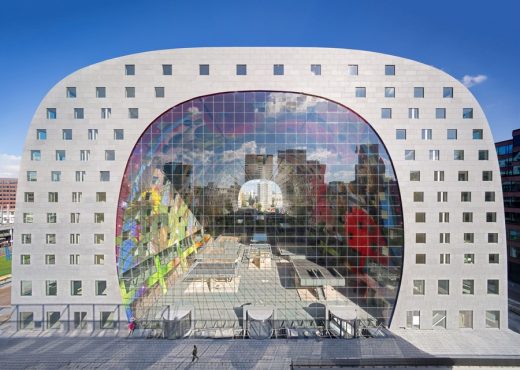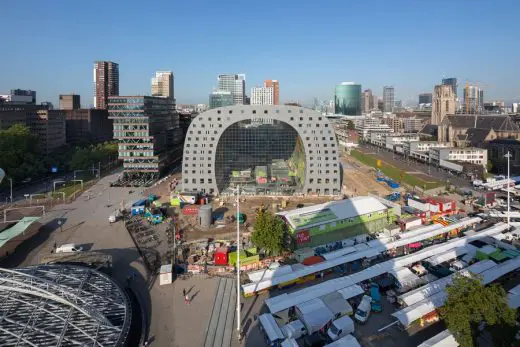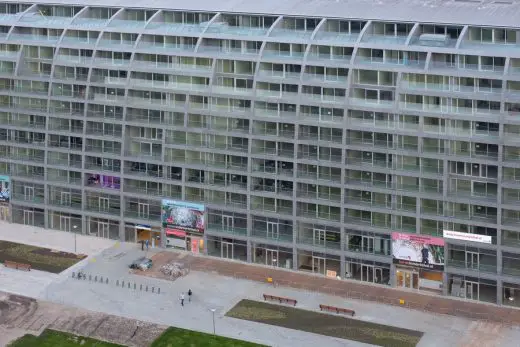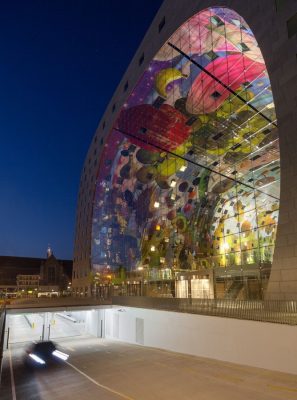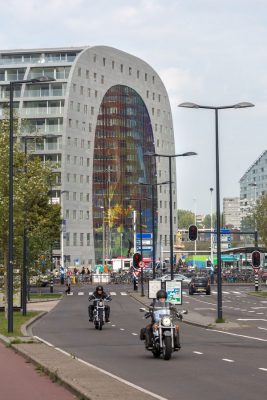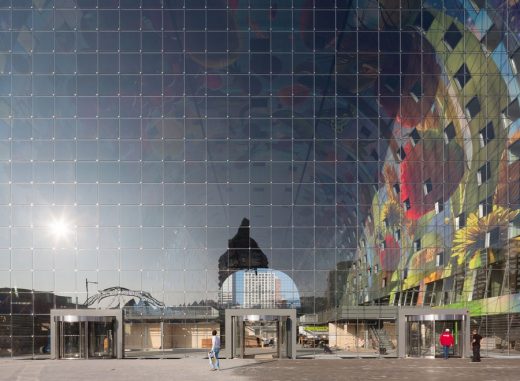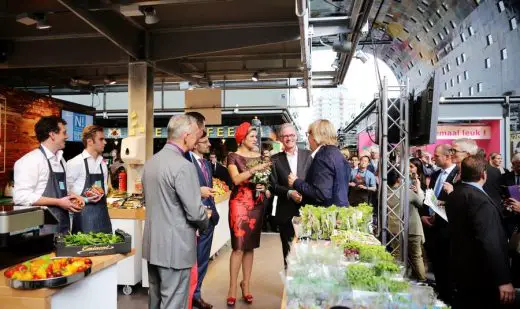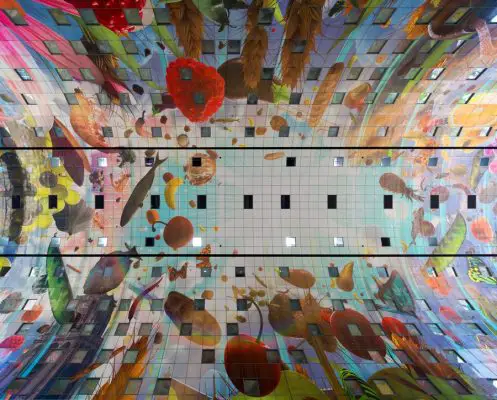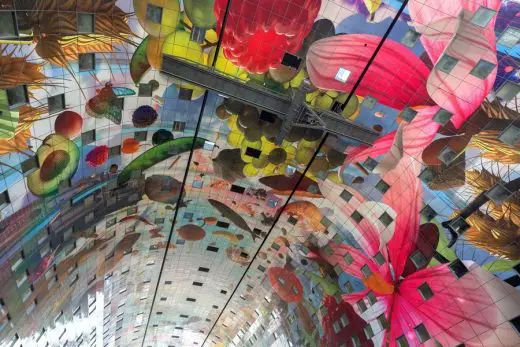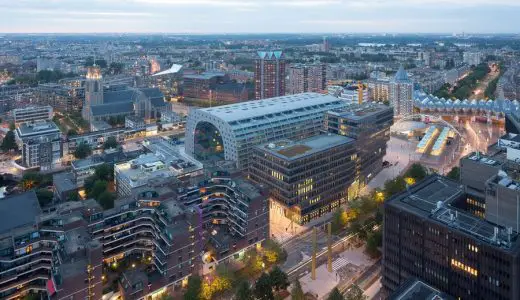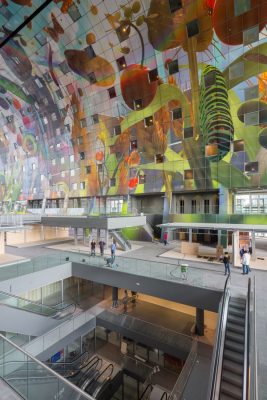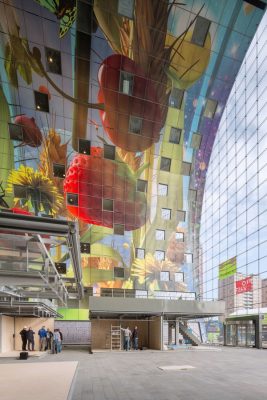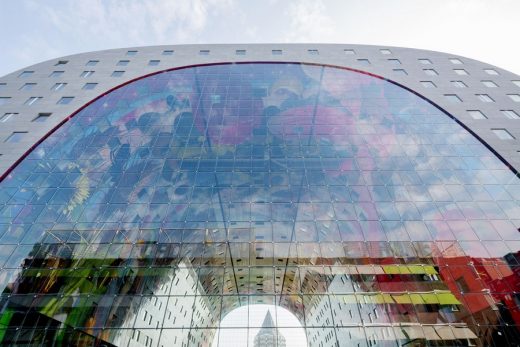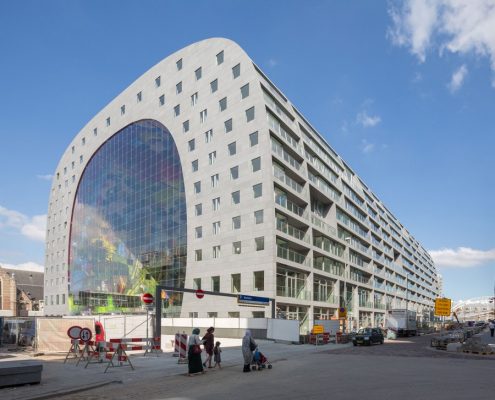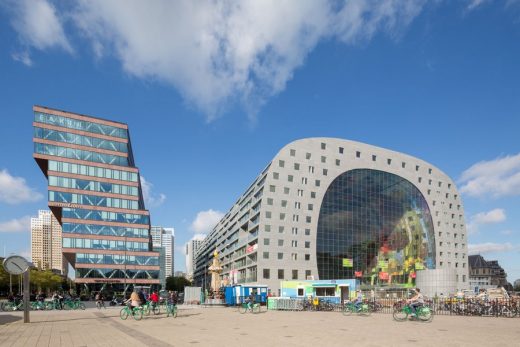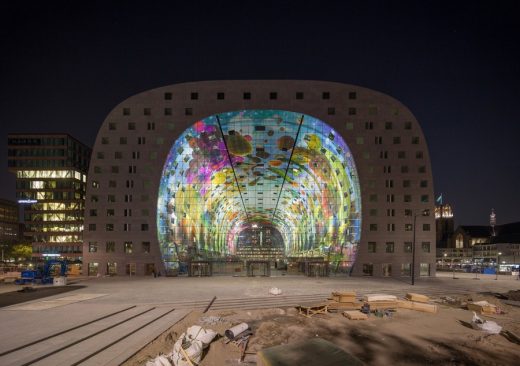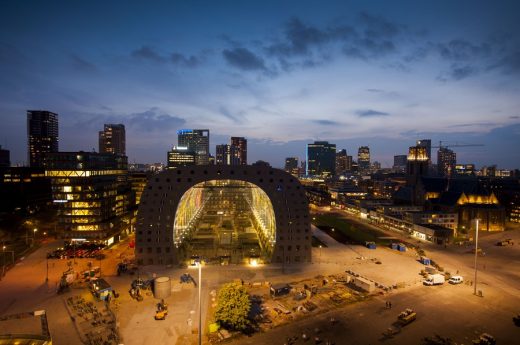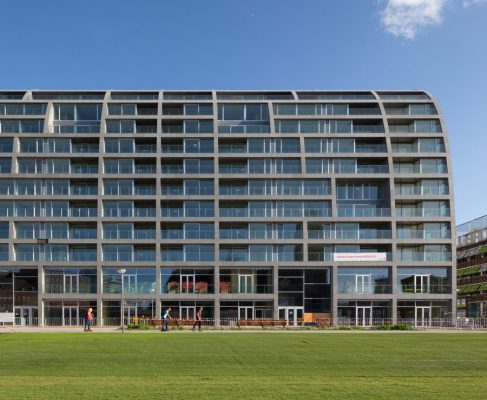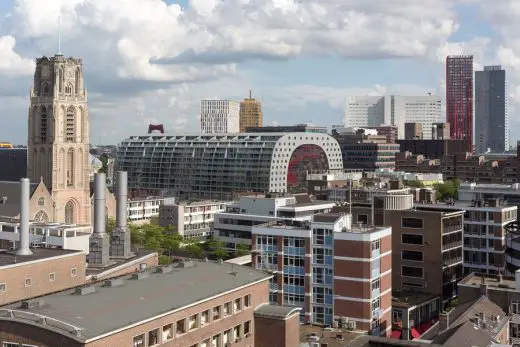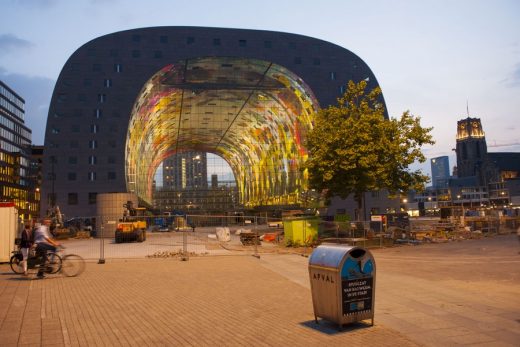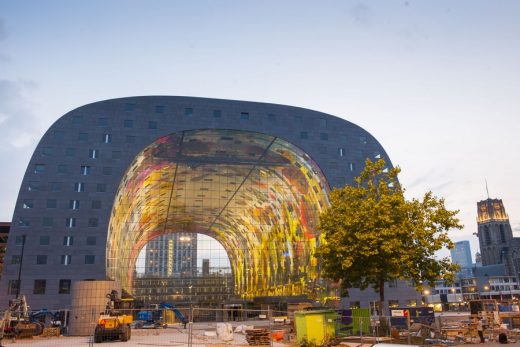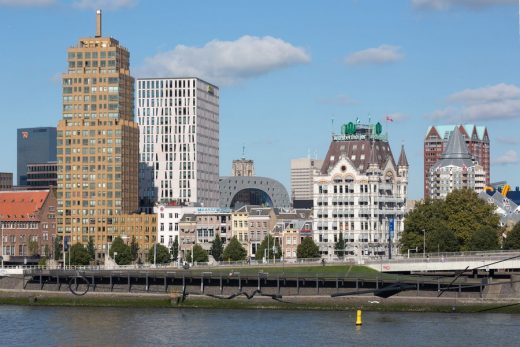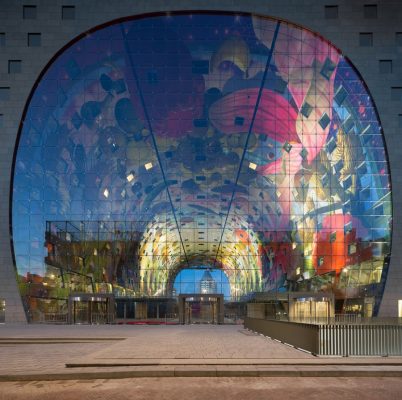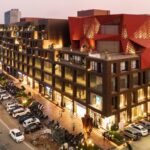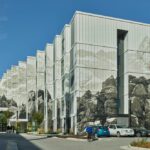Rotterdam Retail Building, Dutch Restaurants Architect, Provast Architecture Design Images
Market Hall in Rotterdam
Netherlands Market Hall Mixed-Use Development design by MVRDV Architects, NL
2 Jan 2015
Design: MVRDV, Architects
Winy Maas and Hans Schröder win Rotterdam’s Marketing Award 2014 for Markthal Rotterdam
Market Hall in Rotterdam Building by MVRDV Architects, The Netherlands:
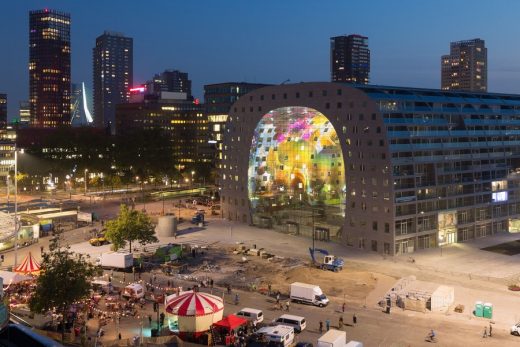
Market Hall Rotterdam
The City of Rotterdam and Rotterdam Partners granted this year’s Marketing Award Rotterdam to Winy Maas and Project Developer Hans Schröder of Provast for their role in creating the ‘new icon of Rotterdam: Markthal. The award is presented annually by Mayor Aboutaleb to people who have contributed to the reputation of the city in an essential way.
The jury report mentions that “with the realisation of Markthal Rotterdam in the city centre something unique was created. In a short period this building has become an absolute must-see. Markthal received in the first weeks already one million visitors. Hundreds of positive publications about Markthal have been published in the national and international press. The project of which the two winners are figurehead has played an essential role in strengthening the reputation of the city and the brand of Rotterdam.”
The Market Hall in Rotterdam Building jury was impressed by the determination and passion of both winners. “They have both within their expertise with a large team of creative professionals realised an important urban transformation. This demands a long-term vision, a combination of creativity and business insight and a passion for Rotterdam.”
Hans Schröder (63) was, until last year, director of Provast developers. Together with his team, MVRDV and a multitude of consultants and construction companies he worked for ten years on Markthal. Winy Maas (53) is co-founder of MVRDV and led the design and realisation of the project.
Markthal Rotterdam was opened on the 1st of October 2014 by Queen Maxima. Markthal is the first covered food-market of the Netherlands and a new urban typology combining living with shopping. The walls and roof of Markthal are an arch of 228 apartments. Inside the arch is the art work ‘Cornucopia’ by Arno Coenen and Iris Roskam, and at 11.000m2, it is the largest art piece in the whole of the Netherlands.
Markthal recently received its two millionth visitors, and was the subject of more than 500 articles in the international press, many of which were filled with positive impressions of the space. The image of Markthal featured in many lists recommending a global audience to visit Rotterdam, published by the likes of CNN, The Guardian, The New York Times, Rough Guides and TIME Magazine, all of whom noted the enormous changes currently underway, which the Markthal marks in Rotterdam, the second city of the Netherlands.
2 Oct 2014
Market Hall in Rotterdam Building
Queen Máxima opens Markthal Rotterdam
Design: MVRDV, Architects
In an official ceremony on Wednesday 1st October, Her Majesty Queen Máxima opened Markthal Rotterdam, a project realized by developer Provast. The opening ceremony was broadcast live on large screens on the square in front of Markthal, where a festival program of street theater, circus, sports and a range of food stalls provided entertainment before the official opening act. At 16:30, Markthal, a design by architecture and urban planning firm MVRDV, opened its doors to the public.
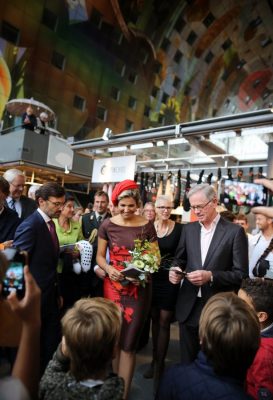
opening photograph : Fred Ernst
The covered market hall in Rotterdam, located in the city center, comprises 96 fresh produce units and 20 hospitality and retail units. The roof of Markthal is shaped by an arch of 228 apartments. A four-story underground car park offers 1.200 parking lots. This combination of market and housing is the first of its kind, making it a world premiere.
Market Hall in Rotterdam building design:
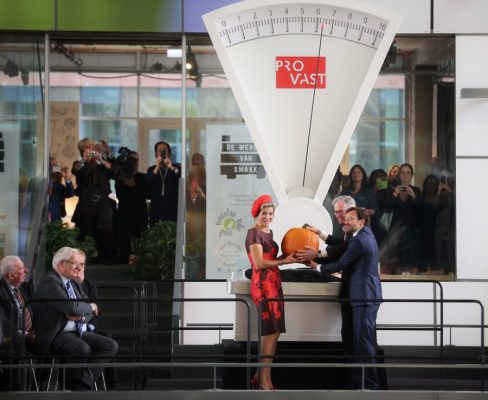
Markthal draws inspiration from food markets in Barcelona, Valencia and Stockholm. Market vendors will offer a diverse range of regional and international products such as fresh fish, poultry, cheeses, coffee, vegetables and fruit, besides a crockery- and a wine shop. Next to the sales units, ‘The World of Taste’, a center for education, information and innovation in the field of healthy eating and the museum ‘The Time Stair’ aim to engage the visitors in the history of food and its development. The Time Stair is a permanent exhibition along the central staircase of Markthal which will showcase the archeological finds discovered during the site excavation.
Markthal will be open seven days a week, Mondays to Saturdays from 10:00 till 20:00, and Sundays from 12:00 till 18:00, with extended opening times for the restaurants. The underground parking Markthal will be open 24 hours a day.
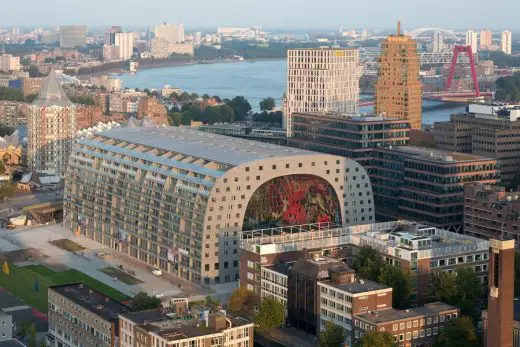
photos above and below : Ossip van Duivenbode
Introduction
Rotterdam has a new icon: Markthal Rotterdam. At a historical location at the Binnenrotte, next to Blaak Station and the largest weekly open air fresh food and hardware market in Rotterdam, the first covered market of the Netherlands was realised. Markthal includes a huge market floor on the ground floor under an arch of apartments. Its shape, its colourful interior and the height turns Markthal into an unique spectacle. Unique is not only its shape and size, but especially the way the different functions are combined. The combination of an apartment building covering a fresh food market with food shops, restaurants, a supermarket and an underground parking is found nowhere else in the world.
Location
Urban transformation
Markthal was a success already before being realised: it is a new and fresh icon which already has attracted large quantities of international press and visitors. The centrally located building is rooted in the city’s history, located parallel to the late medieval ‘Laurenskerk’ (Laurens church) and at the location of the former dike along the river Rotte. This river was diverted at the end of the 19th century in favour of a train line viaduct leading to the south bank of the river Maas.
In the 1990’s this trajectory was rebuilt as an underground tunnel and the current oblong square emerged which offers room for the open air fresh food market twice a week. The 1950’s buildings on either side of the old highline suddenly faced the new square with their backsides and have been replaced ever since.
Markthal means an important impulse to its surrounding area which is a strong contribution to the urban economy. Markthal with its daily fresh food market, shops and apartments, creates coherence and connections in the neighbourhood which will reach a new centrality.
After completion of Markthal, the city of Rotterdam will start to refurbish Binnenrotte Square to make it more attractive also on days that there is no outdoor market. After the refurbishment the outdoor market will be reconfigured, the market lanes will connect seamlessly to the entrances of Markthal, to allow the public to easily enter and exit the building and to create incentives between the two markets, indoor and outdoor.
The building is a new statement in the urban structure of Rotterdam with its high diversity of icons from the days of reconstruction and urban renewal, but also some new buildings that have been realised over the last years. It is in line with the city’s ambition to house more people in the centre and to raise the life quality in post-industrial Rotterdam through a series of large scale projects and countless bottom-up projects. The combination of styles of architecture forms an excellent environment for the spectacular design of Markthal.
Accessibility
Markthal is accessible by all means of transport. Blaak train station is right in front of the building and serves also as metro, bus and tram hub. In 2015 the city of Rotterdam will construct a recessed bicycle parking right next to Markthal with space for 800 bikes. Next to this excellent accessibility by public transport Markthal is also easy accessible by car. The four underground parking levels offer 1.200 parking places.
As part of the general transformation of the ‘Laurenskwartier’ (Laurens quarter) neighbourhood these parking places are not only available to inhabitants but also open to visitors of Markthal, the library, the outside market and tourist attractions in the area. A new traffic plan in the vicinity of the car park entrance will avoid queues, Markthal parking will be open 24/7.
Parking Markthal
The 1.200 parking places are an important addition to the capacity of ‘Laurenskwartier’ (Laurens quarter) neighbourhood and part of the urban transformation. The underground car park is open 24/7 and equipped with latest technology such as a parking guidance system, licence plate recognition, online reservation system and charging points for electric vehicles. Visitors of Markthal, the library, the outdoor market or the city of Rotterdam can park here – as well as the inhabitants of Markthal.
These innovative technologies are geared towards a more sustainable parking: the sophisticated parking guidance system and the license plate recognition help avoid unnecessary driving inside the garage whilst the online booking system is a customer service intervention avoiding traffic in the neighbourhood.
Archaeology
In 2009 and 2010 the Archaeology Department of the city of Rotterdam (BOOR) has conducted a large excavation in the construction site of Markthal. Typical eccentricity in Holland: the archaeological research started at a depth of 3 meters underneath sea level. The Markthal site was extremely interesting for archaeologists as it is the very place where Rotterdam was founded in 1270 by construction of a dike in the river Rotte. In 1340 Rotterdam received the status of a city and was expanded towards the current Blaak station.
In the 16th century the population of Rotterdam grew rapidly. On the site of Markthal was a densely populated neighbourhood with residential buildings and herring fishing companies which were since the 17th century gradually replaced by inn’s, shops and office buildings. During the bombardment in May 1940 all historic urban fabric was destroyed. After the war a school was built on the site which was demolished for the construction of Markthal.
The school moved into an empty office building at the western façade of Markthal, from their class rooms and the roof top playground the pupils have great vistas through the entire length of Markthal. The research by BOOR was executed under great public interest and shows in great detail how a thousand years ago, at the site of Markthal, pioneers started to cultivate the land and made a living.
Museum ‘De Tijdtrap’ (The Time Stair): Middle Ages underneath the Markthal
‘De Tijdtrap’ is a lasting memoir of the archaeological research conducted at the Markthal site. It presents the history of Rotterdam in a vertical exhibition alongside the escalator in the centre of Markthal which connects the hall to the four underground levels. The deeper the escalator goes, the more in depth the history of Rotterdam is presented in a number of displays with findings and models, accompanied by sound and images. Together they tell the story of the beginning of Rotterdam and its history of food.
Architecture
In October 2004 the team of Provast developers and architecture studio MVRDV won a competition organised by the city of Rotterdam for the design and construction of a market hall at Binnenrotte. The municipality wanted to extend the existing open air market with a covered addition. According to stricter European rules in the future the open air sale of fresh and chilled food would not be permitted anymore. Next to this the municipality wanted to augment the amount of inhabitants in the city centre in order to create more capacity for the services in the area.
The demanded programme – housing, parking and a market hall – asked for an obvious solution: two residential slabs with an economically constructible market hall in between. Provast and MVRDV had seen in the South of Europe that these kind of market halls are often dark, introverted buildings with little connection to the surrounding urban area. The Markthal in Rotterdam however was to be an important impulse in the development of the ‘Laurenskwartier’ (Laurens quarter) neighbourhood and had to strengthen the Eastern side of the city centre.
A highly public, open building with good accessibility was needed. The team decided to just flip the two slabs and market which led to a larger hall with two wide openings towards the city. In order to make the construction more efficient a curve was chosen that fitted a traditional elevator core. By adding some space to the lower floors for extra retail space the current volume of the arch emerged 120 meters long, 70 meters wide and 40 meters tall.
The Market Hall building needed to be as open as possible to attract the public and at the same time it had to be closed off due to weather conditions. Keeping the closure as transparent as possible a cable net façade was chosen which needs very few constructive elements. Its principle is comparable to a tennis racket in which the steel cable are used as strings in between which the glass is mounted. This cable net façade is the largest of its kind in Europe. Because of this miracle of engineering the art piece inside is visible from the outside, its lush shapes and colours invite the public to enter the building. The exterior of the Markthal is executed in grey natural stone, the same as on the pavements, to put the emphasis onto the interior.
Markthal is a building without a backside. All sides of the building are accessible or shop windows. The entire supply for the hall, the shops and restaurants is therefore located underground. The first basement floor features an expedition court to which the delivery can happen with vans, from this exhibition court freight elevators reach the market hall.
In this way inhabitants are not hindered by distribution activities that often occur in the early hours of the morning. Also in the basement is an Albert Heijn supermarket, Etos and Gall & Gall. The delivery for these stores is organised through an underground tunnel leading to hidden elevators at Binnenrotte square, in this way larger lorries can operate in distance to the hall. Inhabitants have storage rooms and shared bicycle rooms in the basement.
Inhabitants can reach their apartments through six separate entrances leading to elevators and double helix flight stairs. Due to the curve of the structure the elevator hall is gradually – floor by floor – changing in size and location. At the ground floor the elevator is located at the inner façade, at the top floor towards the outer façade. Each elevator hall services a maximum of four apartments, two of which have windows to the market and all have large glass fronts towards the outside.
Construction
Construction was started October 1st 2009 by contractor combination Mobilis and Martens en Van Oord. Before this the school and parking garage which occupied the site before had been demolished. The school was relocated by Provast into a 1960’s office building right next to Markthal. On its roof is the school playground, kids have fantastic views into the length of Markthal.
Markthal is located at a historical location: the old dike along the river Rotte which was diverted at the end of the 19th century. The soil however is still extremely unstable and wet. To prevent a collapse of the construction site during excavation sheet piles were placed around the entire perimeter of the site. To provide a solid basis for laying the foundations 2500 heavy concrete piles were hammered into the wet soil. Containers were placed along the site as sound barrier.
One of the many specialties during Markthal’s construction was the great depth of the construction site, 15 meters. Groundwater ran already at a depth of 3 meters below street level. As the cofferdam was not supposed to float up during construction the concrete piles were used in this phase as tension piles to keep the site stable. On July, 1 2010 the pile works were completed and a concrete grid was constructed: this was at the same time the future floor structure of the first basement and a protection for the construction site, a smart combination.
Now that the walls were secured, pumps were brought in and made it possible to excavate the site until a depth of 8 meters. This gave the archaeologists space to research the remains of the first settlement of Rotterdam dated 1270. In order to be able to execute the works until the depth of 15 meters below the pavement and to not pressure the walls and floors the site was then filled with water.
One can compare this to a bucket which is lowered down into water, this is difficult if the bucket is empty and easy if the bucket is filled with water. Cranes on floating platforms dug the site up assisted by GPS technology to avoid the concrete construction to be damaged. The last meters were dug out with a sludge piston which was designed especially for Markthal in a way to avoid touching the piles.
In summer 2011 the divers started to lay the reinforcements for the concrete floor 15 meters under water, this was done in heavy duty diving suits, on touch, without any view in the murky water. The concreting took 72 hours. Day and night a 1,5 meter thick layer of underwater concrete was laid, 1500 lorry loads. December 2011 the site was slowly pumped dry, the floor which had to carry a weight of 12.000 kilo per m² appeared watertight. From this moment on, the site was dry and it took another year to complete the underground car park. Then the specialist work was done and contractors changed.
Construction company J.P. van Eesteren started on 1st of October 2012 with the construction of the arch. The construction of the two sides was done fast and economical by means of tunnel shuttering, which worked from the second to the tenth floor. The roof of the arch was realised in four parts supported by a temporary driving construction underneath, a so called Super Support Construction (in Dutch SOC). Inside the concrete, small Wi-Fi-devices indicated whether the concrete was hardening according to plan.
The steel cables of the cable net façade bear a tension of 25.000 to 30.000 kilo, the equivalent of 27 VW Golf cars. Because of this high tension, the cables have grown 9 to 15 cm. The façade is flexible and during heavy storms the wind can push the centre of the façade 70cm inwards, which will make the cables another 4cm longer. In summer 2014 Markthal was closed off by the façade and the construction of the fresh units and stores inside the hall started. For the construction of the market stalls 3 tons of steel was used. At the end of construction but well before the completion date, the Markthal construction site had already attracted 12.000 visitors.
Sustainability
Markthal received a BREEAM Very Good certificate. The building is connected to city heating and a thermal storage system underneath the building which will also heat and cool a number of adjacent buildings in the surrounding area. The various functions in the building can exchange heat and cold. For the hall itself extensive research was conducted to create a comfortable interior climate with an extremely low energy use.
The hall is naturally ventilated, underneath the glass façade fresh air flows in, it rises towards the roof and leaves the hall through ventilation shafts in the roof. This is a thermic system which can function without any installations. A central monitoring system is used to exchange heat and cool between the different programmes, in this way less installations could be used than normal for these programmes. The combination of housing, shopping centre, parking and market hall makes the installation technology more efficient. Inside the market, an information panel illustrates the energy use and CO2 savings of the building. A smart sanitation system is designed to save water.
The design vision of MVRDV describes Markthal as urbanism, the function mix is an integrated design, a 24 hour building which is a public and lasting addition to the city of Rotterdam.
The tenants of Markthal have signed a so called Green Lease Agreement regarding sustainable performance requirements. This covers the use of water, energy, waste and the use of healthy construction material. In this way the sustainable ambition reaches further than just the cask of the building.
An ecologist was invited to improve the ecological value of the inner city location and advised to create space for bats and swifts. On the western façade of the 11th floor are four large bat stays integrated into the façade, on the northern side of the first floor are ten nests for swifts mounted to the wall.
Horn of Plenty
The interior of the arch is covered by the gigantic art piece Horn of Plenty, a multi-coloured creation by Rotterdam artists Arno Coenen and Iris Roskam. The art piece is a five layered digital print made with Pixar Animation software depicting a photographic 3D illusion of fresh products such as fruit, fish, bread, flowers and also the tower of adjacent ‘Laurenskerk’ (Laurens church).
Horn of Plenty refers to the great still-lives of the Dutch golden century, to the Greek mythology in which Cornucopia is a legendary object and to the tradition of artistic arch decoration known from places such as the Sistine Chapel. The artwork evokes the illusion of laying on your back in a meadow, looking up, right through Markthal towards the sky. The sun in the centre figures as Horn of Plenty from which the fresh produce falls down to earth.
Horn of Plenty is one of the largest art pieces of the Netherlands. Its technology is unique, the fresh produce seems photographed but is built in the computer, piece by piece. The 3D impression is detailed in the same resolution suitable for a glossy magazine. In total the image consist of 400.000 megapixels. 1.470 gigabyte have been sent to the printer, in parts, as one computer could never open such a large file.
The 11.000 m² art work have been screwed against the wooden interior facade of the hall in which must have been the largest puzzle of Europe. Each of the 4.500 aluminium panels sized 152 cm by 152 cm needed to be mounted in the right way at the right spot. The 2 mm thick panels are perforated in order to absorb noise from the hall, this helps to create the excellent acoustic profile of the halls interior.
One piece in the centre of the art work is left white; here throughout the entire year an animation will be projected in the evening, this ‘video-mapping’ will change and respond to themes such as season and food.
Food
The entire fresh world underneath one roof
Variety and diversity is key for the market. The market stalls inside the hall and the surrounding restaurants and food stores offer a large variety of kitchens, styles, produce and price levels. The market floor itself has 96 fresh units. The units are arranged back to back and have an average surface of 20 m² and an average front of 9 meters. The units could be rented per piece or per series.
Storage rooms, cooling units and preparation rooms for the units are located on the -1 level. Some units have a glass roof, others have a roof terrace, especially shops with a restaurant or catering service have rented these units and offer their clients the chance to eat and drink with a great view of Markthal. Roofs of other units will be used for urban farming, for growing herbs or vegetables which is not only pretty but useful, the plants have an acoustic function.
A number of units is reserved for pop-up functions and will be used for seasonal products, for example asparagus or herring. On the ground floor and the first floor are about 20 shops and restaurants. All shops are related to food. On level -1 a large anchor store is located, Dutch supermarket Albert Heijn offers consumers the possibility to do all shopping underneath one roof. The fresh market is open daily. Monday till Saturday from 10:00h and 20:00h and Sunday from 12:00h and 18:00h. The restaurants are open longer and all have direct street access.
De Wereld van Smaak – The World of Taste
The edutainment centre ‘De Wereld van Smaak’ gives meaning to food, a story to fresh produce and room for discoveries, experiences and education. The latest trends and developments in food are given a stage. Producers have the chance to get feedback from consumers. ‘De Wereld van Smaak’ is a space that can be adjusted into a living lab, cooking school, presentation room or stage. The multifunctional space will be a meeting place for chefs, hobby chefs, dieticians, kids, senior citizens, passers-by and the entire food business.
‘De Wereld van Smaak’ is an independent cooperative in which a number of commercial parties take part. It inspires and stimulates everyone to make an educated choice for fresh food. It is an interactive platform offering space to all fresh food sectors such as vegetable and food, meat, fish, bread, pastry, dairy, herbs and spices and all related business. They will share their knowledge with each other and the visitors.
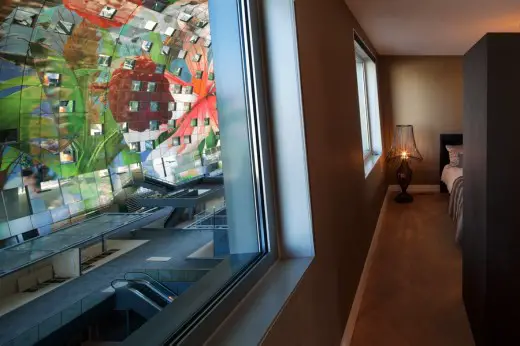
image: Daria Scagliola+Stijn Brakkee
Living
Markthal Rotterdam is a completely new concept, the first building of its kind, a hybrid between market hall and housing. Rotterdam experiences a world-wide scoop with this new urban typology. By using the apartments to create an arch that covers the market a new public building emerges, which could not have been this grand without the housing.
The horse shoe shaped arch of Markthal consists of housing from the third to the eleventh floor, in total 102 rental apartments and 126 apartments for sale. Each apartment has an outside terrace over the full width of the unit and the 24 penthouses on the top floor have – thanks to the arch shape – a very wide roof terrace. The apartments can be accessed via 6 entrances at street level.
Half the apartments has windows to the market, these windows are triple glazed to avoid sound or smell nuisance. There is a broad choice of apartment types, from free layout loft apartments to duplex with multiple bedrooms. The properties vary from 80 to 300 m². The penthouses have their entrances on the tenth floor and inside stairs and room for an elevator to the eleventh floor, in this way the arch of Markthal could be realised without any elevator boxes on the roof.
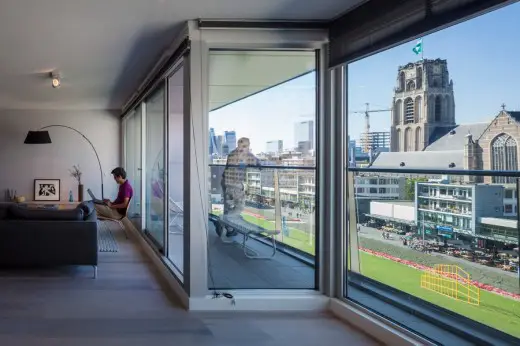
image: Daria Scagliola+Stijn Brakkee
Entrepreneurs
Markthal offers a rich diversity of cuisines, cultures and businesses. It’s a place where one can discover new concepts, and which offers great sales spaces. Not for nothing did the business owners opt for Markthal to sell their products.
Koppert Cress produces cress and young plants (so called Micro-Vegetables). They are based in Westland, the vegetable garden of Rotterdam. As a wholesaler, their products are currently not sold directly to consumers but this will change soon with the opening of their market stall in Markthal, in collaboration with TomatoWorld and the Best Fresh Group. Owner Rob Baan:” Was their another choice?!” When Markthal approached Koppert Cress, they didn’t have to think long.
Even though the Netherlands are a relatively small market for them, Markthal is very important for Rob and his company. “I am pretty chauvinistic and think that we can be proud of what we do. We are still good at horticulture!” Rotterdam was a logic choice for Koppert Cress. “The Netherlands were one of the first countries in the world where the majority of the people live in cities. You have to feed this city.
Urban Farming initiatives, well, I find them very charming. But Westland is the vegetable garden of Rotterdam. The city has forgotten this a bit, and so have we. And there are two main ports that meet each other. Our worlds belong together. And what’s more is that through Markthal I have rediscovered the city. There are so many surprising things happening, in architecture, but also in the culinary field.
De Groene Weg is a chain of twelve biological butchers in the Netherlands. One of them is based in Rotterdam, run by Theo Pronk. Shortly they will open another shop in Markhal. Allard Bakker, general manager of De Groene Weg: ”There we will do something else, something appropriate for the space. As a butcher you need work space. This is very limited in Markthal, so Theo Pronk will take this on. Further it needs to be a bit more like a show. I see it already in front of me that the butcher will take a microphone and show the public how to bone half a pig.”
It also has a bit of an educational function. “Yes, we do that consciously. As an industry we have done everything to lose the consumers’ trust. This we have to reestablish. By being transparent about what we do and of course do what we say we’d do.” What ‘good food’ is exactly, is closely related to what De Groene Weg stands for. “What you put into your mouth has to be tasty, taste is for all people always number one. At the same time we believe that the animals need to have had a good and healthy life. Also our presentation will be special. No pre-packed packages but fresh pieces of meat which the butchers cuts himself for each customer. It should be an experience and you should be able to see the craft.”
Cheese & More is a chain of special cheese shops. The story of Cheese & More started with Henri Willig in 1974 who took over the farm of his parents in Katwoude in North of the country. He and his wife Riet started to produced artisanal cheese. A few years later, a bus full of tourists came to their farm. They wanted to see how it exactly works, how to produce cheese. The people left fully packed with bags of cheeses, and the idea took shape.
Today, the company consists of three farms and nineteen stores. And even though the scale and quantity increased, the cheese is still produced in an artisanal way. Marc Koetsier, retail manager of Cheese & More: “The soul of the company is still the farmer who makes the cheese himself and sells it. We are proud of that, we are still farmers.
It goes directly from the land to the customer, literally.” According to Marc, Markthal is a collection of special things, and as Dutch cheese makers they perfectly fit in there. “The market stall is not going to be a standard stall as you might expect. And you can find here just as well a ham & cheese sandwich. A truly old fashioned, thick piece of ham with good butter and good cheese.” Marc thinks that the wish for honest and artisanal products is very much alive in the Netherlands. “No tricks. Not too complicated, to artificial stuff. Cheese as we have always produced it, that’s what the people look for.”
Events
Markthal distinguishes itself by its special design and function of food related events and meetings. It is a meeting place for all those who enjoy eating and drinking, in the heart of Rotterdam. Collaborations with local initiatives are much sought-after, such as the ‘Belly of Rotterdam’, with whom Markthal will organize a wine festival. Or the ‘Peeking at the Neighbours’ event, which will take place on 4th October. Visitors will have the chance to take a look at one of the apartments and join a minifestival at the just opened market. Of course, the fresh products sold in the Markthal also form part of the programming of the events: ‘Taste the Markthal’ invites everybody to try what Markthal has to offer.
The fresh market produce also plays the main role in the ‘Good Six’, the themed Markthal-bags, which aim to offer the visitors the best of Markthal. This is a nice way to get to know the different stalls and the rich diversity of products. National and international initiatives find their way into Markthal, among which are book presentations, special and surprising demonstrations and pop-up concepts.
Photography: Ossip van Duivenbode, Jan van der Ploeg and Daria Scagliola+Stijn Brakkee
Market Hall in Rotterdam images / information from MVRDV Architects
Location: Rotterdam, The Netherlands, western Europe
New Dutch Building Designs
Contemporary Netherlands Architecture – Dutch architectural selection below:
Another Building by MVRDV in Rotterdam
Spijkenisse Public Library
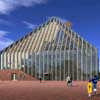
image © MVRDV
Book Mountain
Rotterdam Architecture – Selection
Montevideo – tower
Mecanoo architecten
Montevideo Tower
MVRDV Building Designs
Buildings by MVRDV – Selection
DnB NOR Headquarters Oslo, Norway
DnB NOR Headquarters
Almere Vision 2030, The Netherlands
Almere Vision 2030
Almere Olympiakwartier Masterplan, The Netherlands
Almere Olympiakwartier Masterplan
Comments / photos for the Rotterdam Market Hall Architecture page welcome

